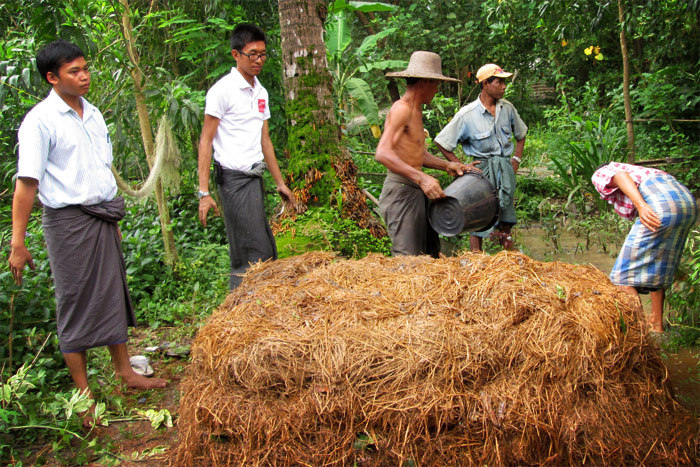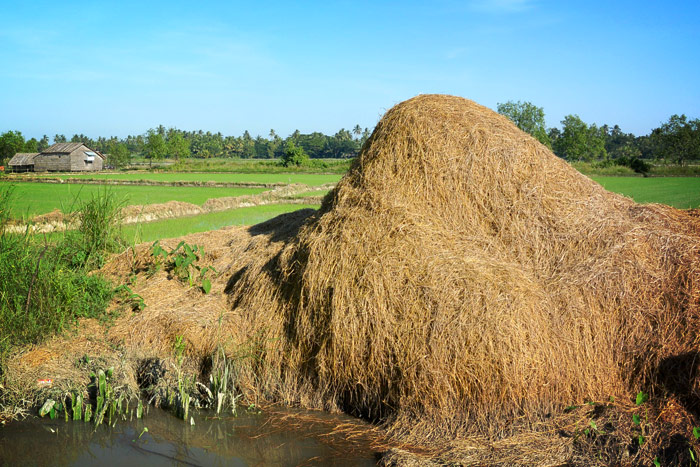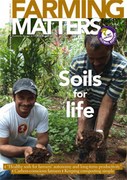More than two decades ago in the Irrawaddy delta in Myanmar, farmers began planting two rice crops each year. Rice production increased, but for how long? Depleted organic matter and acidification are now affecting soil health, and farmers who can’t afford fertilizer are seeing their rice yields declining. This is why 200 farmers started to compost rice straw. With this they have been able to maintain rice yields and reduce fertilizer costs. They are still improving their composting techniques and some are starting to experiment with green manures.
The Irrawaddy delta is Myanmar’s rice bowl. Most land is used to grow paddy rice, and all farmers grow a monsoon and a summer rice crop, using either fresh or brackish water. Once rare, double rice cropping was heavily promoted by government extensionists in the 1990s as part of national food policy. Before the introduction of summer paddy, most farmers planted rice in the monsoon season and a legume in the dry summer season, usually green gram, black gram or groundnut. The legume contributed to soil fertility by fixing nitrogen from the atmosphere and via crop residues incorporated as green manure. Regular flooding during the monsoon also helps add to soil fertility as the water carries nutrient-bearing silts and clays. The introduction of rice double cropping at the expense of a legume in the rotation, has upset the balance of the system, and induced a large increase in the use of chemical fertilizers and a decline in soil health.
According to farmers in the Ayeyarwaddy region, rice yields have been going down over the past ten years. The cause? Reduced soil organic matter, lowering soil fertility and increasing soil acidity (to pH 4). Families typically farm 3-4 hectares, but keep few livestock. Most families have a few pigs and ducks, a couple of buffalos for traction, but cattle are rare. Manure is limited. But many farmers are finding it increasingly difficult to buy more and more fertilizer each year, leading to a cycle of debt.
What to do with rice straw?
Overturning composting myths
Throughout our work with family farmers around the world, views on composting have often surprised us. Composting is probably the most widely promoted practice by NGOs under the banner of agroecology. But agroecological development programmes are disappointing when restricted to certain techniques and don’t explore complementary practices such as green manures, crop associations and rotations. And many misconceptions remain.
“Composting needs specific infrastructure and materials such as cement pits, plastic tanks, special fencing, tarpaulins and nets.” WRONG!
“Composting needs special formulas and specific ingredients such as effective micro-organisms.” WRONG AGAIN!
These can speed up and improve composting but must not be promoted as essential. Perfect prescriptions are an enemy of good results, and such myths deter wider adoption as they depend on costly external inputs, and more labour and hassle. As one farmer told us, “Have you ever tried to shovel compost out of a cement pit? It is truly backbreaking!” Extra costs and effort discourage farmers and development workers, sometimes to the point of abandoning composting as a technique all together.
With double cropping and not many animals, rice straw is abundant in the delta. After harvest, large heaps can be seen everywhere, most remaining in the fields the whole year until they are finally burnt or thrown into nearby rivers, with only the decomposed bottom part of the mound used as an organic fertilizer.
The abundance of straw and other green matter suggests the huge potential of compost to rebuild soil health in the delta. But their soils need much more organic matter, and composting can transform the abundantly available rice straw and other plants into forms of organic matter to provide nutrients and reduce acidity.
GRET gets involved
In 2008, cyclone Nargis devastated the delta killing more than 150 000 people and destroying homes and farm assets of hundreds of thousands more. The NGO GRET started a programme of emergency assistance, but which progressively transformed into a number of agroecology initiatives with family farmers.
Today, GRET works in 88 villages, with two main target groups, landless and resource-poor farmers, and rice farmers with at least two hectares and who sell rice in local markets, and provide extension services, support farmer to farmer knowledge sharing, and support community business organisations. And most recently GRET started a composting programme in the delta area and green manure trials in both the delta and western Myanmar.
Simplicity
The first step was to encourage our five local extensionists to use an agroecological way of thinking, focusing on soil health, and different composting methods were demonstrated and discussed.
And when they started sharing their knowledge on composting with 300 farmers in 30 villages, the key message was: “Anybody can do it and with any locally available biomass – the key words being simplicity, flexibility, and affordability.” During hands-on training sessions, groups of farmers helped to make compost piles and a few weeks later, turned them and saw the composting process. Farmers immediately began to make their own compost piles, landless farmers for their home gardens using neighbours’ rice straw mixed with household waste and pig and poultry manure.
Rice farmers first produced compost for their rice nurseries and seed plots, but producing enough compost for all their fields was a challenge.

Compost made easy
In 8-12 weeks, the straw from a hectare of paddy can produce 2.5 tonnes of good quality compost, which when added to the soil provides 50 kg of nitrogen, or 40-50% of the total nitrogen requirements of a rice crop. Cutting fertilizer costs by half is a huge advantage for farmers as they struggle with debt from the need to buy more and more fertilizer each year.
The basic compost combination is dry matter, fresh green matter and a microbial input. Rice straw, dried leaves and even coconut fibre are good sources of dry matter. Freshly cut leaves and weeds, banana trunks, water hyacinth, or any plants in and around the fields and gardens are used as green matter. The microbial input helps to transform the biomass into the nutrient-rich material we call compost, whether it is fresh soil, forest humus, animal manure or fresh compost. Handfuls of wood ash add phosphorus and potassium and even the basic combination can be adapted. If a farmer has no more green matter, he will still get compost but of a different quality. And if manure is in short supply, it helps to add a diluted solution of cow or pig dung with rice straw and other dry matter. This promotes the growth of microbes, nitrogen content and decomposition, and is a cheap and easy way to overcome the lack of green matter or manure.
Needs time
Depending on the materials, four people can build a compost pile of about 10-12 cubic metres in a day, yielding 1-2 tonnes of compost after 8-12 weeks. But labour is a problem. As one farmer, Mr U Maung Aye said, “Compost making is made difficult by our time and labour constraints, especially for collecting the materials needed to make a big compost pile.” So, farmers and scientists are now testing various labour saving mixtures, piling techniques and microbial solutions. The latest trial is on making compost piles during rice threshing, with microbial solutions sprayed onto the straw to promote decomposition.
But even with optimised composting approaches, most farmers still can’t produce enough for all of their fields, so additional soil building practices are needed. The once common practice of rotating rice with a legume is being revived. One year ago 16 farmers started experimenting with black gram as a green manure, and GRET will help to analyse the results. They plan to also start experimenting with other green manure species that produce more biomass and are resistant to water logging.
But quickly spread
Over the past year, farmers have built more than 200 compost piles, are testing different techniques and are already experiencing benefits. Cost savings by reducing fertilizer purchases are immediately felt, as one farmer noted: “Composting takes more time but it is more effective. When I only apply chemical fertilizer, my field flushes green for two weeks. But when I apply both compost and fertilizer, the paddy keeps its bright green colour for much longer.” One ‘compost fan’ even bought a cow to scale up his production and has set up an impressive composting unit.
The short-term outcomes have been strikingly positive, not only because farmers have so readily started their own experiments, but also because the soil health benefits are already evident. The medium and longer term impacts should be even more promising for the Irrawaddy delta, as farmers continue to experiment with compost and other complementary practices.
Celine Allaverdian and Stephane Fayon
Both authors work for GRET in Myanmar, a French development NGO that has been actively fighting poverty and inequalities for 38 years. Celine Allaverdian (allaverdian@gret.org) is the livelihoods project manager and Stephane Fayon (stephan8@auroville.org.in) is a tropical agroecology expert.


